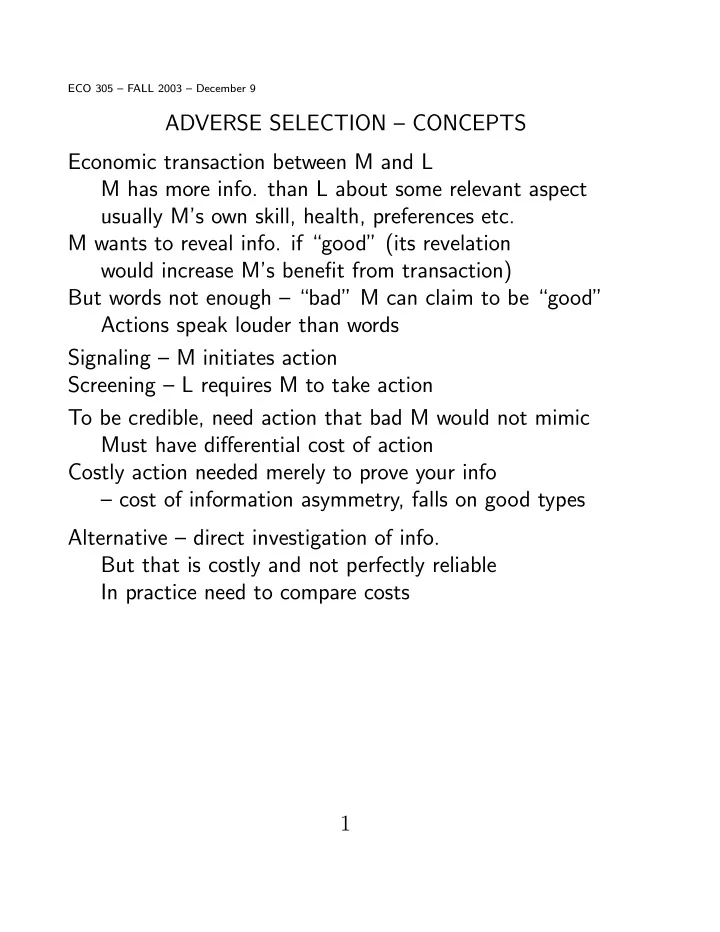

ECO 305 — FALL 2003 — December 9 ADVERSE SELECTION — CONCEPTS Economic transaction between M and L M has more info. than L about some relevant aspect usually M’s own skill, health, preferences etc. M wants to reveal info. if “good” (its revelation would increase M’s bene fi t from transaction) But words not enough — “bad” M can claim to be “good” Actions speak louder than words Signaling — M initiates action Screening — L requires M to take action To be credible, need action that bad M would not mimic Must have di ff erential cost of action Costly action needed merely to prove your info — cost of information asymmetry, falls on good types Alternative — direct investigation of info. But that is costly and not perfectly reliable In practice need to compare costs 1
AKERLOF’S “LEMONS” EXAMPLE Private used car market; each potential seller knows more about quality of his own car than potential buyers Suppose potential buyers know nothing; for them any car on the market is indistinguishable from the average Suppose quality Q in the full population of used cars, as measured by value in hands of seller, is uniformly distributed in [0 , 1] Quality Q car’s value in hands of buyer = 3 2 Q Since buyers can’t fi nd out Q of any speci fi c car Price P must be same for all cars on the market Sellers who know their own Q is < P will sell; those with Q > P won’t So cars on the market are not representative sample of the full population of used cars but an “adversely selected” sample of low-quality cars uniformly distributed in [0 , P ] , not the full [0 , 1] Average is 1 2 P ; so risk-neutral buyers willing to pay 3 1 2 P = 3 4 P < P 2 Sellers with 3 4 P < Q < P drop out This is true for any P , so no end to process Complete collapse of market ! Reality not that bad; but in this market it is especially di ffi cult to fi nd good credible signals 2
SIGNALING AND SCREENING SPENCE’S JOB MARKET MODEL Two types of workers A and C, productivities A > C Each worker knows own type Population proportions θ of C, (1 − θ ) of A Firms compete for limited numbers of workers So with full and symmetric information: Wages W A = A , W C = C If no way to convey productivity information: Everyone gets wage W = (1 − θ ) A + θ C Education as signal of productivity: Each unit of education (year, tough courses) costs α to type A, γ to type C, with crucial di ff erential cost condition α < γ Separating equilibrium: Competing fi rms believe that anyone with x or more units of education is type A, else type C Wage as function of education y ( C if y < x W ( y ) = A if y ≥ x For equilibrium, beliefs must be correct, that is : 3
A-types choose to acquire y = x , C-types choose y = 0 “Incentive-Compatibility” or “Self-Selection” constraints A − α x > C, C > A − γ x A − C > x > A − C α γ Range of x , so continuum of such equilibria, each sustained by its own beliefs If education has no other value, then the one with the lowest x is best Even this in fl icts costs: A-types get " # A − α A − C 1 − α A + α = γ C < A γ γ The cost is solely to prove they are not type-C Type-C exert “negative externality” on type-A Separation can be achieved by screening where fi rms require enough education to pay A Or by signaling, where worker takes initiative gets enough education to be credible proof of type-A If you are type-A, and don’t use an available signal, you will be taken for a type-C 4
General result — excessive investment in signals Pooling can be Pareto superior: Type C get same C , but type-A get more if " # 1 − α A + α W = (1 − θ ) A + θ C > γ C γ or θ < α / γ (few C-types in population). But pooling cannot be equilibrium: If pooling going on, and everyone gets W , any one A-type can acquire education x 0 such that A − γ x 0 < W < A − α x 0 or θ ( A − C ) < x 0 < θ ( A − C ) γ α and so credibly separate himself Again this could be initiated by fi rm or worker So pooling may have to be enforced by policy Similar to cream-skimming in insurance 5
SCREENING --�AIR�FARES First�v.�economy�class,�or�Unrestricted�v.�restricted Two�types�of�travelers�with�different�willingness�to�pay First�(F) Economy�(E) Airline’s�cost�of�carrying/seat 200 100 Willingness Business�(B) 600 300 to�pay Tourist�(T) 250 200 Total�1000�passengers,�of�whom�b�are�business�flyers A.�If�airline�can�identify�the�type�of�each�individual�passenger Offer�each�B�an�F�seat�for�(just�under)�600,� each�T�an�E�seat�for�(just�under)�200 ����Total�profit�=�(600-200)�b�+�(200-100)�(1000-b) ������=�400�b�+�100�(1000-b) B.�If�airline�cannot�identify�the�type�of�each�individual�passenger ����(i)�All�F�configuration� B �either price�250,�everyone�buys,�profit�50�(1000) price�600,�only�B�buy,�profit�400�b Latter�better�if�b�>�125 ����(ii)�All�tourist�class price�200,�everyone�buys,�profit�100�(1000) price�300,�only�B�buy,�profit�200�b Latter�better�if�b�>�500
���(iii)�Both�classes,�price�x�for�first,�y�for�economy Incentive-compatibility�constraints�(IC)�: Want�T�to�self-select�E�:�250�-�x�<�200�-�y,��OR�x�-�y�>�50 ��������Want�B�to�self-select�F�:�600�-�x�>�300�-�y,��OR�x�-�y�<�300 Participation�constraints�(PC)�:�x�<�600,�y�<�200 Total�profit�=�b�(x-200)�+�(1000-b)�(y-100) ��=�1000�(y-100)�+�b�(x-y-100) To�max�this,�want�to�make�y�and�(x-y)�as�large�as�possible, subject�to�the�IC�and�PC�constraints So�y�=�200,�x�-�y�=�300�and�then�x�=�500 Can’t�raise�x�to�600:�that�would�require�y�>�300. Total�profit�=�b�(300)�+�(1000-b)�100 Airline’s�optimal�policy� B � ���If�b�<�500,�use�B-iii,�price�discrimination�with�self-selection ���If�b�>�500,�use�B-i,�all�first�class�(don’t�serve�the�tourists because�that�forces�lower�prices�for�business�flyers) For�each�b,�height�between�A�and�B-i�or�B-iii�(as�relevant) ���is�the�airline’s�reduction�in�profit�b/c�of�asymmetric�information
ESSENTIALS�OF�SIGNALING�AND�SCREENING 1.�Infer�information�(type)�from�action Mere�words�often�lack�credibility (Unless�it�is�common�knowledge�that the�players’�payoffs�are�well�aligned) 2.�Rely�on�differences�between�types about�costs�(or�benefits)�of�different�actions 3.�"Bad"�types�have�incentives�to�mimic�"good"�types ����So�separation�requires�excessive�costly�action ����This�is�a�negative�spillover�from�bad�types�to�good 4.�Signaling� B �action�is�initiated�by�informed�player ����Screening� B �action�is�taken�by�informed�player�at�the insistence�of�the�less-informed�player 5.�"No�news�is�bad�news"�principle�of�signaling ����If�signal�of�good�type�is�known�to�be�available and�you�don’t�send�that�signal then�others�will�assume�you�are�bad�type ����Example� B �exercising�pass/fail�option 6.�No�or�multiple�equilibria No�equilibrium�if�pooling�and�separation ���can�alternately�beat�each�other Multiple�equilibria�if�level�of�signal�needed�for ���credibility�is�arbitrary,�depends�on�expectations
Recommend
More recommend